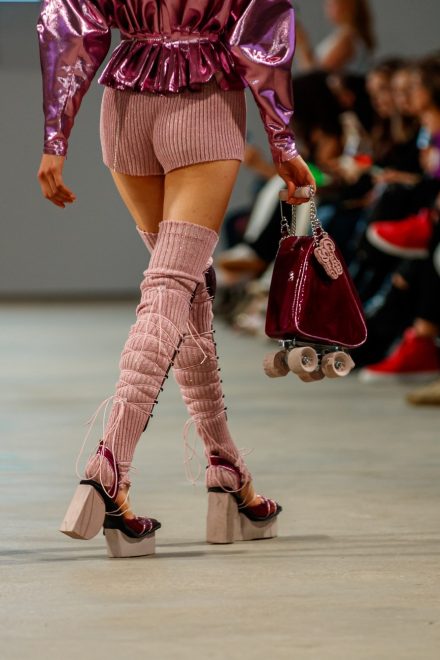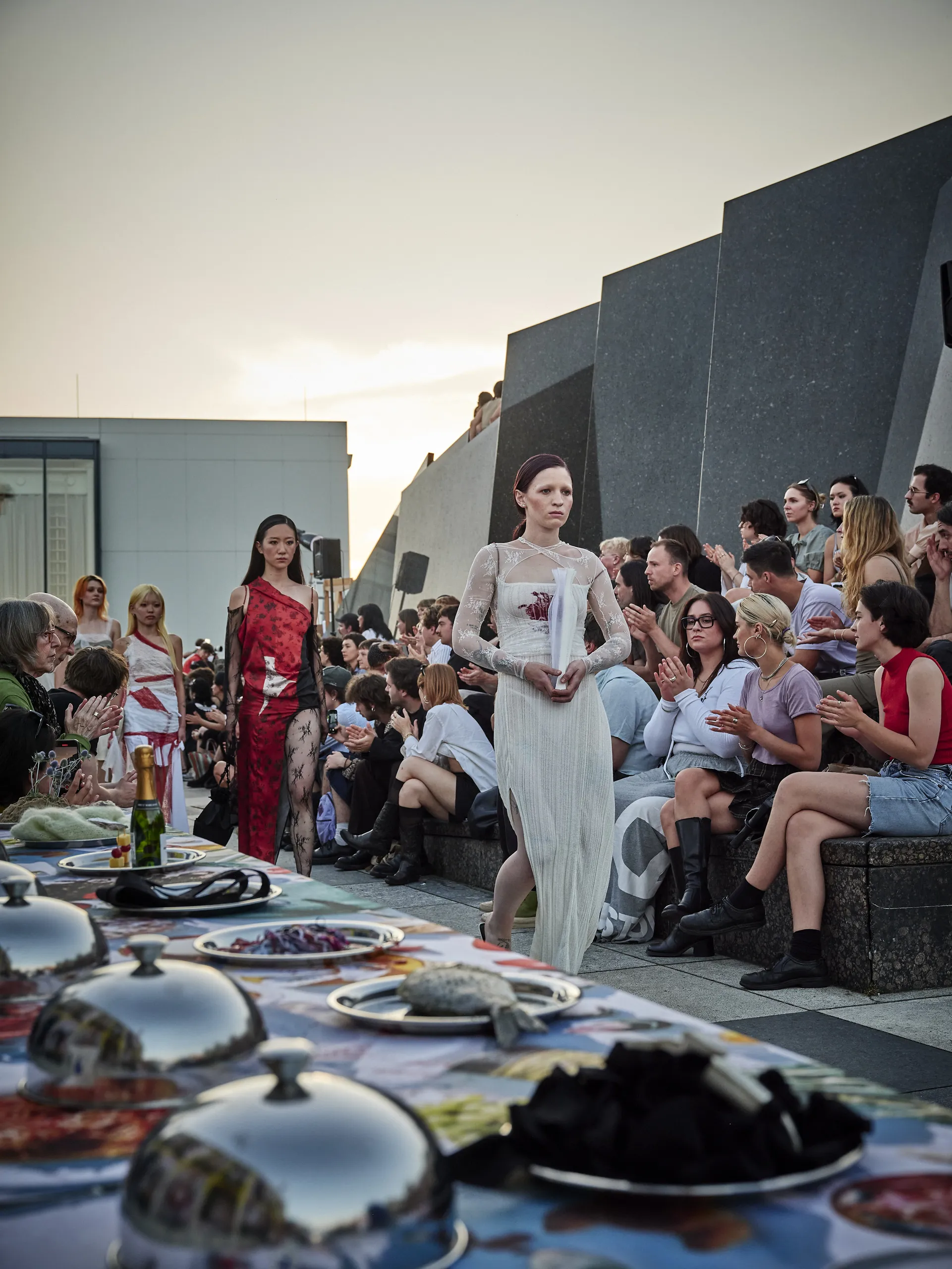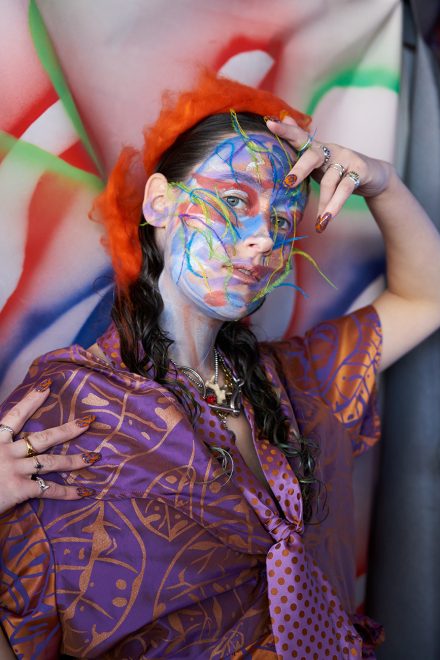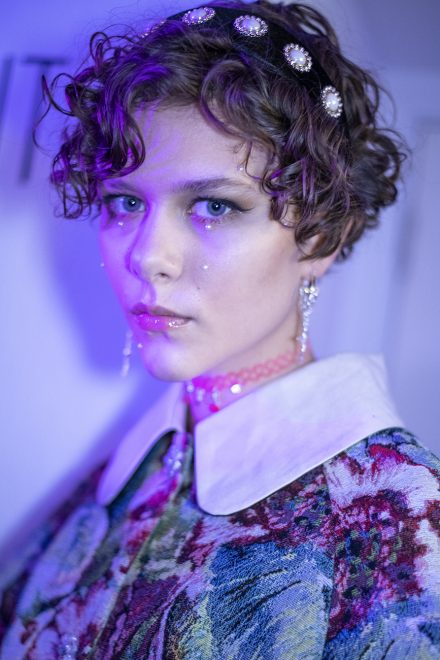German designer Lisa Oberländer recently graduated with an MA in Fashion Design from Universität der Künste. Her collection was presented as part of this year’s graduate show: Schau21. We caught up with her after the show to find out more about OVERALLOVER and why one man’s trash is another man’s treasure.
Œ: You’re an “Echte Berlinerin” (true Berliner), somewhat a rare find in the city! Do you feel like growing up in such a creative hub influenced you to become a designer?
Lisa: I was born and grew up in the middle of Berlin and my whole family is based here. Thanks to my parents, I was always surrounded by very different and interesting people, who came to Berlin in the early 90s. When I was a child, I was always drawing and crafting. I decided at a very young age that I wanted to become a designer and I always had a thing for dressing myself specially or differently and seeing how people would react.
Œ: So you started studying fashion right after finishing school?
Lisa: One year after high school, I applied to UdK Berlin for fashion design and got accepted. During my time at UdK, I did a lot of internships with Berlin-based designers. It was important to me to work closely with the designers and to get insights into the challenges of starting and developing your own label. I finished my BA in 2016 and started to work in the costume department on different film sets because I wanted to explore another way to express my creativity. After a few years working in the industry, I started to miss designing clothes, especially the whole creative process attached to it and thus decided to go back to UdK Berlin to do my Master’s degree.
 |
 |
Œ: Who or what inspires you the most in your creative process?
Lisa: The people who surround me – my friends, my family in particular. No matter if they have any interest in fashion, I like to talk to people and know about the way they dress and why. What makes clothes precious to us? Which types of clothing make us feel comfortable or attractive? What do we expect from our clothes?
Œ: What makes this collection so unique?
Lisa: The main part of my collection is the overalls. I always had a thing for this piece of clothing and dealt with it in earlier projects at UdK. For my MA collection, I always put two different but colour-matching boiler suits together to one overall. Some of them play on the first impression that they are two pieces of clothing – for example, a shirt and trousers – but it is all one garment. For each one, I developed another solution for the way it is closed at the inside and how the different pieces of clothing are connected to appear as one.
My overalls are explicitly gender-inclusive. I want people who wear them to feel comfortable in their clothes and their body. Overalls for me are the perfect garment to cover the body yet allow it to move in the way one intends.
 |
 |
Œ: What led you to choose the materials you did to work with?
Lisa: For my collection, I did a lot of research on work clothing and I came across one story that fascinated me: there is a tradition of hand-knitted jumpers at the Guernsey-Islands. The fishermen and their families knitted them especially for their daily work, each family and port had their special knitting pattern. So if you found a drowned fisherman you could tell by the pattern of their pullover to which homeport to return their body. The jumper was knitted very tight on the arms and the neck so it could not slip from the body when falling into the sea.
The colour of the pullover is traditionally navy-blue and if there were holes, for example, on the elbows they took new yarn to repair the arm. Because the older yarn was faded by the use and from sea salt, it results that there were lots of different shades of blue. The history of this jumper is the perfect example of clothing that is a useful and thoughtful piece of workwear and a very personal one, too.
As an addition to my overalls, I wanted to create something similar. Something which, on one hand, covers and protects the body, and on the other hand, tells something about the person wearing it. This is how the initial idea was conceived: to knit the form of bare breasts. The prototype I knitted by myself and then, later on, I had produced it in a small company in Thuringia by machines. I find it very important that we find a connection to our clothing – that we appreciate it more in form of repairing broken things or reusing them for new creations.
The shoes I used for my collection are all second-hand purchases. The first pair I did were my own. They had a crack but I didn’t want to throw them away. So I used a technique called “visible mending”, which allowed me to repair the shoes and “redesign” them at the same time.
Œ: As you move on to establishing your own brand, what should we expect from your future collections?
Lisa: I thoroughly enjoyed working on this collection and I still have some boiler suits and lots of ideas leftover. So basically, I want to start a label. As I have three focal points in my collection – the overalls, the pullover and the shoes. I will develop further each one for itself because I think each one has a lot of potential!
I also want to point out a different approach to our clothing. We don’t have to throw away everything old, used or broken and even when I run out of boiler suits I could imagine lots of different materials to evolve the techniques I have developed.
 |
 |
Fashion – Lisa Oberländer
Photography – Kaśka Jankiewicz
Hair and Make-up – Juliane Schulz and Antonia Peix
Models – Rika and Christophe






